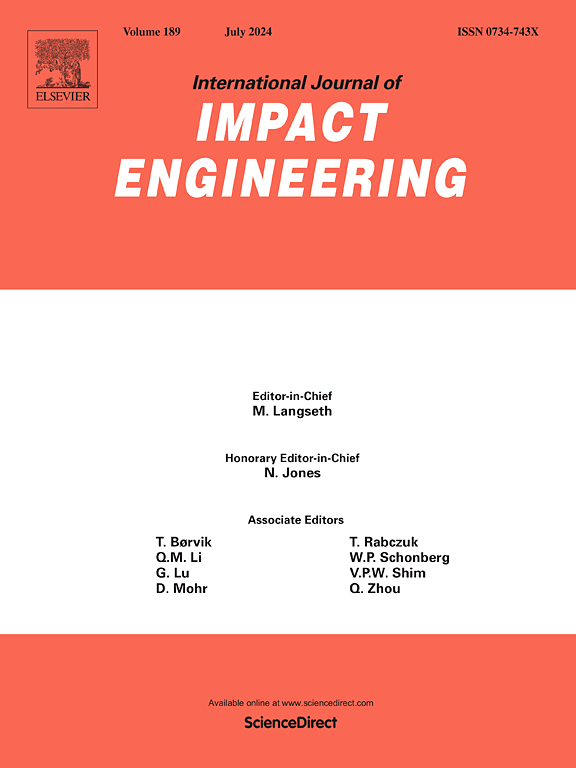使用 SLM 工艺评估 316L SS Gyroid 和 Diamond 结构的压缩性能 - 静态和动态压缩载荷下的实验方案
IF 5.1
2区 工程技术
Q1 ENGINEERING, MECHANICAL
International Journal of Impact Engineering
Pub Date : 2024-10-16
DOI:10.1016/j.ijimpeng.2024.105147
引用次数: 0
摘要
实验研究了由各种三周期最小表面(TPMS)拓扑结构组成的一组 4 个结构在能量吸收效率方面的相对比较。这些 TPMS 结构是使用 316L SS 通过选择性激光熔融 AM 工艺打印而成的。研究考虑了各种参数的影响,如相对密度、压缩加载方向和加载速率、菱形和陀螺型 TPMS 的单元格数量,以及片状和骨架状拓扑结构。研究的目的是从表观应力和应变、动态增强和比能量吸收(SEA)方面量化它们的结构响应,并从坍塌稳定性方面评估它们的结构完整性。结果表明,具有恒定壁厚和均匀几何形状的片状 TPMS 结构比骨架式结构具有更好的能量吸收能力。在片状结构中,菱形结构比陀螺型结构更受关注。相对密度从 20% 增加到 30%,其特点是制造质量提高,能量吸收能力增强,压缩过程中的渐进变形更加均匀。总体而言,这套 TPMS 几何结构的能量吸收能力优于目前用于冲击工程应用的其他传统蜂窝材料。最后,在第一种方法中,可以利用图表开发一种原创的设计方法,在能量吸收能力和 TPMS 结构的设计几何参数之间建立联系。本文章由计算机程序翻译,如有差异,请以英文原文为准。
Evaluation of compression behaviour of 316L SS Gyroid and Diamond structures using SLM process – Experimental programme under static and dynamic compression loadings
The relative comparison in terms of energy absorption efficiency for a set of 4 structures made of various Triply Periodic Minimal Surfaces (TPMS) topologies is experimentally investigated. These TPMS structures are printed by Selective Laser Melting AM process using 316L SS. The study is carried out in consideration of the effect of parameters such as relative density, compressive loading directions and loading rates, number of unit cells for Diamond and Gyroids TPMS both declined for Sheet and Skeletal topologies. The objective is to quantify their structural responses in terms of apparent stress and strain, dynamic enhancement and Specific Energy Absorbed (SEA) and to evaluate their structural integrity in terms of collapse stability. The results reveal that the Sheet pattern of TPMS structures with its constant wall thickness and uniform geometry exhibits better energy absorption capabilities than the Skeletal pattern. The Diamond family shows greater interest rather than the Gyroid family only in the case of the Sheet pattern. The increase in relative density from 20 to 30 % is characterised by improved manufacturing quality, an increase in energy absorption capacity and more homogeneous progressive deformations during compression. On the whole, the set of TPMS geometries exhibits energy absorption capacities prior to those of other conventional cellular materials currently used for impact engineering applications. Finally, in a first approach, an original design methodology using charts can be developed to establish a link between the energy absorption capabilities and the design geometric parameters of TPMS structures.
求助全文
通过发布文献求助,成功后即可免费获取论文全文。
去求助
来源期刊

International Journal of Impact Engineering
工程技术-工程:机械
CiteScore
8.70
自引率
13.70%
发文量
241
审稿时长
52 days
期刊介绍:
The International Journal of Impact Engineering, established in 1983 publishes original research findings related to the response of structures, components and materials subjected to impact, blast and high-rate loading. Areas relevant to the journal encompass the following general topics and those associated with them:
-Behaviour and failure of structures and materials under impact and blast loading
-Systems for protection and absorption of impact and blast loading
-Terminal ballistics
-Dynamic behaviour and failure of materials including plasticity and fracture
-Stress waves
-Structural crashworthiness
-High-rate mechanical and forming processes
-Impact, blast and high-rate loading/measurement techniques and their applications
 求助内容:
求助内容: 应助结果提醒方式:
应助结果提醒方式:


